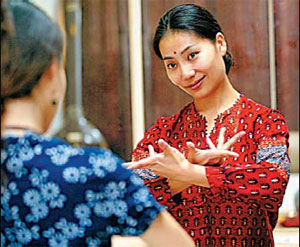Dressed in an Indian gown and with a red spot on her forehead, Jin Shanshan sat cross-legged on a small Indian carpet. In front of her on the ground lay a Talam, a wooden instrument used as the metronome in India. She chanted "ta ta ta" as she struck out beats on the Talam. She watched a girl quickly stamping her feet and dancing different poses. Once in a while, Jin stood up and demonstrated to her student the right hand gestures and facial expressions.
"This is how a dance class goes in India. Teachers sit and beat the Talam most of the time, except that they need to correct students' movements," Jin says.
Twice a week, the Beijinger teaches an-hour's Indian dance at a popular Indian restaurant, which is run by several Chinese. And an owner is one of her two students.
Though not a professional dancer herself, Jin possessed a formidable understanding of classic Indian dances.
Jin developed a love for Indian dance as a child. When other girls were busy playing dolls, she used to wrap her mother's scarves around her head and body. Then she would imitate Indian performances in front of a mirror.
"One reason that I wanted to learn Indian dance is because people kept saying that I had dark complexion and big eyes and looked like characters in old Indian movies when I was in kindergarten," she says.
In 1983, Jin was enrolled in a children's art center opened by the prestigious Chinese Oriental Song and Dance Ensemble, where she started six-year's strict discipline of Indian dances.
Every weekend, she would ride an hour on a bicycle from her home to the center. "I never missed a class. I dreamt of dancing and singing on the stage one day," she says.
After graduating from high school, Jin was admitted to Peking University and majored in Hindi and Indian culture. She was sent to India to further her study of Hindi at the Jawaharlal Nehru University (JNU) in 1994. "But for me, it was a rare chance to touch the real Indian dance," she says.
Upon the recommendation of Zhang Jun, an esteemed expert in Indian dance, Jin studied under Indian dance master Birju Maharaj for a year.
Later she found it difficult to cast aside her passion for Indian dance even when she held an enviable job in a foreign company and earned a considerable salary. She quit the job and went to India in 1998 where she became the only Chinese student of Leela Samson, another Indian dance master.
Into just months she completed the courses which ordinary Indian students would take four years to finish. She practiced from morning to night, constantly scraping her hands on the 1.8m ceiling of her rented flat.
Eventually her dedication paid off when she successfully held a solo dance show at the end of her studies. "It was a very important ceremony in India, which meant that I had completed my study."
From then on, Jin traveled widely across India. Annually, she stays with Leela Samson for a month and continues her exploration of Indian dance and culture. And her family has built an intimate relationship with the master.
Jin has also witnessed the remarkable changes in exchanges between the neighboring countries.
"I remember during my first trip in India, the most-asked questions of locals were like, 'do you have five-star hotels in China?' And 'are Chinese women still feet binding?'" When I strolled on New Delhi's streets in 1998, I was often mistakenly recognized as Japanese or South Korean. I told people I came from China, and they all looked amazed. There were few Chinese students there," she says.
But Jin notes that since 2002, more and more Chinese companies and self-sponsored Chinese students have arrived in India. Many of her former Indian schoolmates at JNU now work for travel agencies, guiding an increasing population of Chinese tourists in recent years.
(China Daily January 15, 2008)


